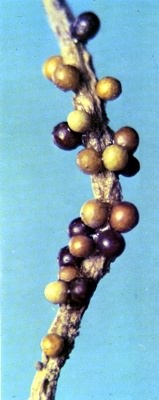Pests
Globodera rostochiensis (Woll.) Behrens - Golden Nematode, Potato Cyst Nematode.
Systematic position.
Type Nemathelminthes, class Nematoda, subclass Secernentea, order Tylenchida, family Heteroderidae, genus Globodera.Biological group.
Obligate parasite.Morphology and biology.
Coelelminth of microscopic size. Eggs reniform (100 x 45 microns on average). Larvae of 1st and 2nd stages (450 x 23 microns) vermiform, rolled inside egg. Larvae of 3rd and 4th stage bottle-shaped, thickened in the middle part of body. Females spherical, with vermicular head end (0.38-1.07 x 0.27-0.96 mm); males vermicular, length of their body is up to 1.2 mm. Nematodes parasitize in roots. During their mass settling, growth and development of plants is delayed. Depressed, "palm-like" potato plants appear in fields in "bald patches". Such plants form a few fine tubers, and their roots are frayed. At the end of vegetation, golden "grains" are found there. Those are cysts of the nematode, which fall to the ground in autumn. Every cyst contains several hundred eggs and invasive, 2nd-stage larvae. In spring, at soil temperatures of about 6°C, the larvae leave cysts, and, with stimulation of plant root exudations, they find and invade them in the ground. In damp ground they can only travel distances of 30 cm. In roots, they become motionless, eat, molt, and develop, forming 3rd- and 4th-stage larvae that produce white females and transparent males. The males, breaking through bark root, go into the ground, find and impregnate females, and perish. Females produce eggs, which remain inside their bodies. Larvae of 1st and later 2nd stage develop there. By the end of plant vegetation, the females turn into cysts -- internal organs die off, and external integument hardens, becoming golden and then brown.Distribution.
Distributed throughout all regions of potato cultivation. Large and strongly infected areas are known in Non-Chernozem and Central areas of European Russia, in Byelorussia, Ukraine and the Baltic region, as well as in Armenia. The overwhelming majority of the population centers occur at family farms because of potato monoculture. They are sources of cyst distribution in fields. Recently, annual increases in population and population density are characteristic because of the absence of nematode control measures.Ecology.
The species is monovoltine, ecologically plastic. Invasive larvae in cysts remain in anabiosis for 10 years in the absence of host plants (potato, tomato, eggplant), in dry ground and in adverse temperatures. Therefore, the nematode is distributed throughout both northern (Murmansk Region) and southern (Stavropol Territory) regions. However, temperate climates and fertile soils are optimum for nematode development. Various factors, especially porosity of ground and presence of moisture in the soil, are important during the period of larvae movement to roots. Further influence of environmental conditions on parasitizing nematodes is executed through the plant. The most important for worms is food supply, which is related to different factors, such as potato variety, state of plants, and nematode density in roots. The combination of these factors causes autoregulation of population density through reduction of female fertility and development of male larvae.Economic significance.
The species are found in quarantines and small farms, the main site of potato production. There are two aspects of harmfulness: losses caused by quarantine restrictions on potato realization, especially seed potato, and direct losses of yield. The latter reaches 2% with soil contamination of 100-160 larvae/100 cm3 and 70% at 2000-3000 larvae/100 cm3. Strategy of control includes reduction of population to economically low density. Therefore, resistant varieties of potato and uninfected cultures are used in crop rotation.Related references:
Anan.eva I.N. 2003. Distribution of Golden Potato Nematode in Byelorussia. In: Plant protection (Minsk), Iss. 27, p. 27-30 (in Russian)Behrens E. 1975. Globodera Skarbilovic, 1959, eine selbstandige Gattung in der Unterfamilie, Heteroderinae Skarbilovic, 1947 (Nematoda: Heteroderidae). I, Vortragstagung, aktuellen Problem der Phytonematologia am 29.5.1975 in Rostock. Manuskriptdruck der Vortrage. Rostock, p. 12-26.
Eglitis V.K., Kaktynya D.K. 1972. Heteroderosis and ditilenhosis of potato in Latvian SSR. Pitseskis S., ed. Short reports on plant protection (8th Baltic conference on plant protection). Kaunas: MSKh LitSSR. Part 2: 97-100 (in Russian)
Ekhamaa A.P. 1977. Detection and control of Potato Nematode (Heterodera rostochiensis W.) in Estonian SSR. PhD Thesis, Tallin, 42 p. (in Russian)
Karapetian Y.A., Mkrtchian H.S., Tatevosian F. 1999. Biology of PCN in Armenia. In: Problems of Nematology. St. Petersburg: International Nematology Symposium, 82-83 p.
Ministry of Agriculture of the Russian Federation, State inspection on plant quarantine of the Russian Federation, All-Russian Research Institute of Plant Quarantine. 2003. Reference-book on quarantine phytosanitary state of the Russian Federation for January, 1 2003. Moscow: MSKH RF, 102 p. (in Russian)
Nazarova N.V. 2003. Harming activity of Golden Potato Nematode. Zashchita i karantin rastenii 12: 34 (in Russian)
Shestiperov A.A., Savotikov Yu.F. 1995. Quarantine phytohelminthoses. Moscow: Kolos, 447 p. (in Russian)
Sigareva D.D., Pilipenko L.A., Sosenko E.B. 1999. The problem of cyst nematodes in Ukraine. In: Problems of Nematology. St. Petersburg: International Nematology Symposium, 89-90 p.


